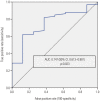Concomitant Wrapping of a Moderately Dilated Ascending Aorta during Aortic Valve Replacement: Postoperative Remodeling of a Distinctive Aorta
- PMID: 31887798
- PMCID: PMC6938774
- DOI: 10.3349/ymj.2020.61.1.40
Concomitant Wrapping of a Moderately Dilated Ascending Aorta during Aortic Valve Replacement: Postoperative Remodeling of a Distinctive Aorta
Abstract
Purpose: The long-term outcomes of aortic wrapping in patients with ascending aortic aneurysms, which are rare, but can be fatal, remain poorly understood. This retrospective study analyzed the outcomes of aortic diameter, including aortic root, ascending aorta, and proximal arch diameters, after aortic wrapping during aortic valve replacement surgery.
Materials and methods: Ninety-six patients with ascending aortic dilation of 40-55 mm who underwent aortic wrapping during aortic valve replacement were selected for this study. Aortic diameter was measured at three levels perioperatively and at follow-up (median time of 9.1±4.2 years). A linear mixed-effects model was used to analyze aortic diameter expansion.
Results: Freedom from adverse aortic events (aortic dissection or rupture, reoperation, or sudden death) at 10 years was 97.9%. No significant dilation at the level of the sinuses of Valsalva (0.069 mm/year, p=0.524) or ascending aorta (0.152 mm/year, p=0.124) was observed. Significant dilation occurred at the proximal aortic arch (0.343 mm/year, p=0.006). Subgroup analysis with a multivariable linear mixed model identified initial ascending aortic diameter to be a significant predictor of proximal arch dilation (p=0.032). Receiver operating characteristic curve analysis revealed that the cut-off for the prediction of proximal arch redilation was an initial mid-ascending aortic diameter of 47.0 mm (area under the curve 0.747, 90% confidence interval 0.613-0.881, p=0.023).
Conclusion: Aortic wrapping could be considered as a safe and long-term therapeutic option. Redilation of the proximal arch should be carefully observed during long-term follow-up.
Keywords: Aortic aneurysm; aorta; aortic valve.
© Copyright: Yonsei University College of Medicine 2020.
Conflict of interest statement
The authors have no potential conflicts of interest to disclose.
Figures




Similar articles
-
The long-term fate of ascending aorta aneurysm after wrapping versus replacement.J Thorac Cardiovasc Surg. 2022 Aug;164(2):463-474.e4. doi: 10.1016/j.jtcvs.2020.12.110. Epub 2021 Jan 19. J Thorac Cardiovasc Surg. 2022. PMID: 33597100
-
Fate of remnant sinuses of Valsalva in patients with bicuspid and trileaflet valves undergoing aortic valve, ascending aorta, and aortic arch replacement.J Thorac Cardiovasc Surg. 2017 Aug;154(2):421-432. doi: 10.1016/j.jtcvs.2017.03.150. Epub 2017 Apr 28. J Thorac Cardiovasc Surg. 2017. PMID: 28599977
-
Management of dilated ascending aorta during aortic valve replacement: valve replacement alone versus aorta wrapping versus aorta replacement.J Thorac Cardiovasc Surg. 2013 Oct;146(4):802-9. doi: 10.1016/j.jtcvs.2013.06.007. Epub 2013 Jul 13. J Thorac Cardiovasc Surg. 2013. PMID: 23856198
-
Aortic root replacement in the setting of a mildly dilated nonsyndromic ascending aorta.J Thorac Cardiovasc Surg. 2023 Oct;166(4):983-993. doi: 10.1016/j.jtcvs.2022.03.044. Epub 2022 Jun 3. J Thorac Cardiovasc Surg. 2023. PMID: 35863966 Review.
-
[Aneurysms of the ascending aorta and aortic arch].Chirurg. 2014 Sep;85(9):758, 760-66. doi: 10.1007/s00104-014-2716-z. Chirurg. 2014. PMID: 25200626 Review. German.
References
-
- Borger MA, Preston M, Ivanov J, Fedak PW, Davierwala P, Armstrong S, et al. Should the ascending aorta be replaced more frequently in patients with bicuspid aortic valve disease? J Thorac Cardiovasc Surg. 2004;128:677–683. - PubMed
-
- Davies RR, Goldstein LJ, Coady MA, Tittle SL, Rizzo JA, Kopf GS, et al. Yearly rupture or dissection rates for thoracic aortic aneurysms: simple prediction based on size. Ann Thorac Surg. 2002;73:17–27. - PubMed
-
- Vega J, Gonzalez D, Yankovic W, Oroz J, Guaman R, Castro N. Thoracic aortic aneurysm. Natural history, diagnosis and management. Rev Chil Cardiol. 2014;33:127–135.
-
- Erbel R, Aboyans V, Boileau C, Bossone E, Bartolomeo RD, Eggebrecht H, et al. The Task Force for the Diagnosis and Treatment of Aortic Diseases of the European Society of Cardiology (ESC) 2014 ESC guidelines on the diagnosis and treatment of aortic diseases: document covering acute and chronic aortic diseases of the thoracic and abdominal aorta of the adult. Eur Heart J. 2014;35:2873–2926. - PubMed
MeSH terms
LinkOut - more resources
Full Text Sources

